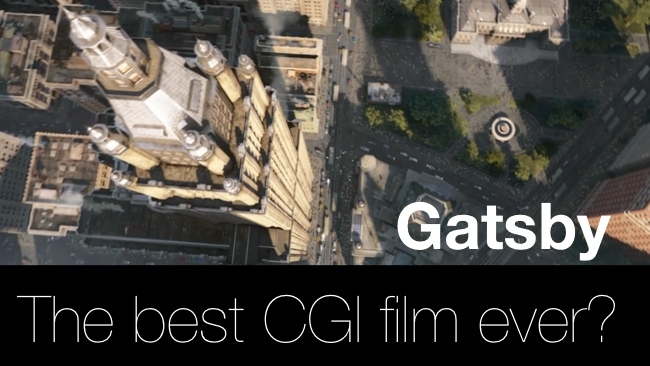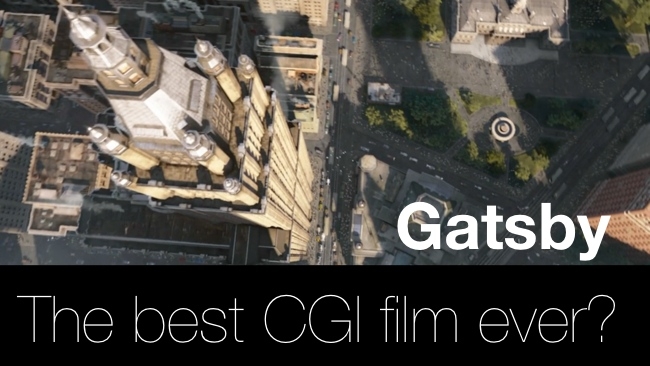
 The best CGI film ever
The best CGI film ever
Baz Lurhmann's The Great Gatsby is built not around expensive sets but probably some of the best CGI ever seen (well, we should probably say "apart from Gravity" - which, although it's in a CGI league of it's own, is not exactly a historical costume drama)
I watched The Great Gatsby a few days ago. I've always liked the novel, and I'd seen a tantalising CGI breakdown, and wanted to see how all that wizardry was integrated into the film. The question for me was: will it detract from the story, or will it fade into the background, like good CGI should do (unless it's the focus of the plot).
In fact, it was neither of these.
Adding CGI
What CGI was able to add to the film was an additional dimension of freedom. I'm not talking about the third dimension here (or at least, only partially). What it was able to do was to give the scope and flexibility to move around the sets, and to create a convincing landscape and geometry around which the plot was based.
Perhaps the best example of this was the way viewers were helped to visualise the spacial relationship between the houses of Gatsby himself and his rival Tom Buchanan. Gatsby's house is in the fictional town of West Egg, and Buchanan lives in East Egg. The properties are distantly visible to each other, separated by a wide stretch of water.
Buchanan's house has a pier that stretches into the water, terminated by a slowly blinking green light. This lantern is used as a somewhat abstract leitmotif throughout the film.
From Paper to the Big Screen
Of course, the film is based on a novel, which in itself is quite capable of creating and sustaining images like these through the quality of the prose and the readers' imagination alone, but the fact that the book can do this so effectively means that it puts a big responsibility on the film maker to not destroy or distort this imagery when it is rendered on the big screen.
The way that these scenes were realised in the film is an object lesson in how to take this responsibility and turn it into a visual triumph.
Lurhmann achieved this through a mixture of perceived realism and dreamy impressionistic license.
The scenes around the water between West Egg and East Egg were shrouded in mist or milky sunsets. There was always the sense that "this is an idealised view, but it's completely in context with the idealised lifestyles of these two mega-wealthy American fictional characters".
But when the action shifted to New York, or the road between Long Island and NYC, it was hyper real. It's hard to judge how much of this sense of actuality was due to historical accuracy (I have no idea how true to 1920s New York it actually was) or whether it was down to the glistening novelty of seeing live-action downtown New York in full colour, complete with the electric billboards and neon signage that were common even back then.
Making Fantastical Scenes a Reality
That much of this was CGI, meshed with live action, shot in front of a blue screen, was completely invisible. The imagery was completely seamless. It was a triumph of set design, CGI and motion-tracking.
There were some iconic shots in the film that could not have been made in live action. In one scene, we started at the top of a skyscraper, and then - all in first person point-of-view - we jumped off the building, plummeting towards the swirling crowds below. As soon as it was possible to discern the faces of the people on the ground, we zoomed in towards Nick Carraway, a central figure in the film and the story's narrator. Just before the virtual camera hit the ground, it levelled up at face-hight, and we saw Carraway looking up at the building, clearly thrilled by the prospect of working in the New York.
The theme of a camera making impossible moves was revisited as the camera was "flown" from Buchanan's mansion, across the water, to Gatsby's pier, where the subject of the novel was looking wistfully towards the flashing green light.
We knew that we were in for a visual treat from the very beginning of the film, which started in black and white, with a border of American Art Deco kitsch. Soon after, we saw real historical film of the time, which had been colorised. It's an old trick, but extremely effective here.
There were more "flying" shots as we were taken through Buchanan's garden towards the entrance to his house. Visually, it was magnificent, and there was absolutely no hit of artificiality as we saw guests arriving, perfectly blended with the computer-generated images.
In between New York and Long Island, there was a stretch of land where frantic building was taking place. The boom on Wall Street was nourishing the rapid expansion of the city. Some of the best scenes were shot in this somewhat fictitious industrial wasteland, where the greyness of the ash and grime was mitigated only by the yellow lights from peoples' windows. Several times in the film, the protagonist drives through this dull hinterland, which serves to emphasise the colour and vibrancy of the city on his arrival. Needless to say, the quality of the CGI in providing the backdrop to all of this is quite breathtaking.
As a huge fan of science fiction, I never thought I'd see a historical drama that had more "wow" in it than a space-based battle or a scene on an alien planet.
If ever there was a film rendition of a classic American novel to recommend to science fiction fans, this would be it.
Compiling the VFX Shots
Here's a clip showing how the VFX shots were put together - almost 1500 of them in total.
Chris Godfrey was the VFX supervisor on the film. He managed to get Baz Lurhmann's permission to show this breakdown.
He's what Chris has to say on his Vimeo page:
My name is Chris Godfrey and was the VFX supervisor on the film.
Baz has graciously agreed to let us release this 'before and afters' reel to show our peer group the VFX work completed on his film 'The Great Gatsby'. While this specific reel was the work of Animal Logic (as my primary vendor), in total I worked with 7 vendors including Animal Logic, Rising Sun and Iloura in Australia, ILM in San Francisco and also Prime Focus and Method Vancouver. We also ran an amazing internal SWAT team that completed over 400 shots. Congratulations to all who did such fabulous work on almost 1500 shots and especially to Andy Brown from Animal Logic who put this sequence together.
Many thanks to Baz, CM, Catherine Knapman, Chris DeFaria and Mark Brown - and of course Prue Fletcher and Joyce Cox.
Video
Tags: Post & VFX


Comments